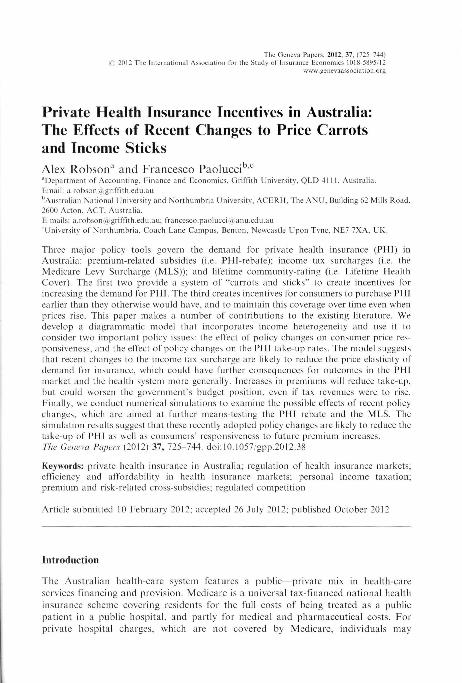Private health insurance incentives in Australia : the effects of recent changes to price carrots and income sticks

Contenido multimedia no disponible por derechos de autor o por acceso restringido. Contacte con la institución para más información.
| Tag | 1 | 2 | Valor |
|---|---|---|---|
| LDR | 00000cab a2200000 4500 | ||
| 001 | MAP20120043800 | ||
| 003 | MAP | ||
| 005 | 20121026135116.0 | ||
| 008 | 121018e20121008esp|||p |0|||b|spa d | ||
| 040 | $aMAP$bspa$dMAP | ||
| 084 | $a344.1 | ||
| 100 | 1 | $0MAPA20120024212$aRobson, Alex | |
| 245 | 1 | 0 | $aPrivate health insurance incentives in Australia$b: the effects of recent changes to price carrots and income sticks$cAlex Robson, Francesco Paolucci |
| 520 | $aThree major policy tools govern the demand for private health insurance (PHI) in Australia: premium-related subsidies (i.e. PHI-rebate); income tax surcharges (i.e. the Medicare Levy Surcharge (MLS)); and lifetime community-rating (i.e. Lifetime Health Cover). The first two provide a system of carrots and sticks to create incentives for increasing the demand for PHI. The third creates incentives for consumers to purchase PHI earlier than they otherwise would have, and to maintain this coverage over time even when prices rise. This paper makes a number of contributions to the existing literature. We develop a diagrammatic model that incorporates income heterogeneity and use it to consider two important policy issues: the effect of policy changes on consumer price responsiveness, and the effect of policy changes on the PHI take-up rates. The model suggests that recent changes to the income tax surcharge are likely to reduce the price elasticity of demand for insurance, which could have further consequences for outcomes in the PHI market and the health system more generally. Increases in premiums will reduce take-up, but could worsen the government's budget position, even if tax revenues were to rise. Finally, we conduct numerical simulations to examine the possible effects of recent policy changes, which are aimed at further means-testing the PHI rebate and the MLS. The simulation results suggest that these recently adopted policy changes are likely to reduce the take-up of PHI as well as consumers responsiveness to future premium increases | ||
| 650 | 1 | $0MAPA20080573867$aSeguro de salud | |
| 650 | 1 | $0MAPA20080578237$aSeguros privados | |
| 650 | 1 | $0MAPA20080601508$aEstudios estadísticos | |
| 650 | 1 | $0MAPA20080586294$aMercado de seguros | |
| 651 | 1 | $0MAPA20080638146$aAustralia | |
| 700 | 1 | $0MAPA20100059364$aPaolucci, Francesco | |
| 773 | 0 | $wMAP20077100215$tGeneva papers on risk and insurance : issues and practice$dGeneva : The Geneva Association, 1976-$x1018-5895$g08/10/2012 Volumen 37 Número 4 - octubre 2012 , p. 725-744 |

